The 7 Types of Organizational DNA
An exclusive survey shows most companies possess traits that inhibit their ability to execute.
(originally published by Booz & Company)
 |
|
Illustration by Brian Cairns |
We like to use the familiar metaphor of DNA to codify the idiosyncratic characteristics of a company. (See “The Four Bases of Organizational DNA,” s+b, Winter 2003.) Like the DNA of living organisms, the DNA of living organizations consists of four building blocks, which combine and recombine to express distinct identities, or personalities. These organizational building blocks — structure, decision rights, motivators, and information — largely determine how a firm looks and behaves, internally and externally. (See Exhibit 1.)
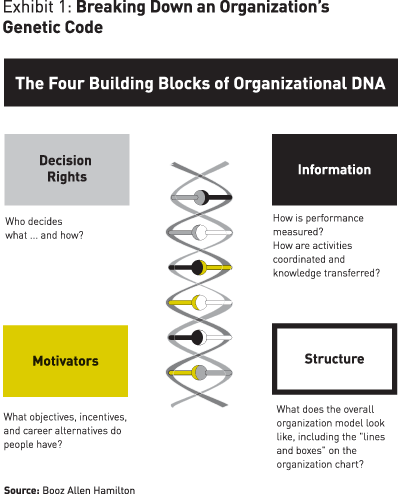
Last year, we developed a short, online self-assessment tool called the Org DNA Profiler™ (www.orgdna.com) to measure an organization’s relative strength in each of these four areas, on the basis of individual employees’ responses to 19 questions. Survey responses are fed through proprietary software to generate one of seven prototypical organizational profiles — or, to continue the genetic metaphor, “species.” (See “The Seven Organizational Species,” below.)
|
The Seven Organizational Species |
|
In working with companies to diagnose and overcome organizational impediments to effective execution, we have identified seven broad types of organizations: The Resilient Organization. This organization is flexible enough to adapt quickly to external market shifts, yet it remains steadfastly focused on and aligned with a coherent business strategy. This forward-looking organization anticipates changes routinely and addresses them proactively. It attracts motivated team players and offers them not only a stimulating work environment, but also the resources and authority necessary to solve tough problems. The Just-in-Time Organization. Although not always proactive in preparing for impending changes, this organization has demonstrated an ability to “turn on a dime” when necessary, without losing sight of the big picture. Although it manages to hold on to good people and performs well financially, it has not made the leap from good to great. This organization tends to miss opportunities by inches rather than miles, and to celebrate successes that are marginal rather than unequivocal. Despite its frustrations, however, it can still be a stimulating and challenging place to work. The Military Organization. Often driven by a small, hands-on senior management team, this organization succeeds through sheer force of will, the will of its top executives. It can conceive and execute brilliant strategies — sometimes repeatedly — but its middle-management bench can be shallow and short lived. This organization’s biggest liability is preparing for growth beyond the tenure of its current leaders. Junior talent in this organization typically learns by seeing rather than doing, and middle management often defects as up-and-comers realize they must leave the nest to get flying experience. The Passive-Aggressive Organization. So congenial that it seems conflict free, this is the “everyone agrees but nothing changes” organization. Building a consensus to make major changes is no problem; implementing them is what proves difficult. Entrenched, underground resistance from the field can defeat a corporate group’s best efforts. Lacking the requisite authority, information, and incentives to undertake meaningful change, line employees tend to ignore mandates from headquarters, assuming “this too shall pass.” Confronted with an apathetic organization, senior management laments the futility of “pushing Jell-O.” The Fits-and-Starts Organization. Scores of smart, motivated, and talented people populate this organization, but they do not often pull in the same direction at the same time. When they do, they can execute brilliant, breakout strategic moves, but the organization typically lacks the discipline and coordination to repeat these successes on a consistent basis. It is an environment that lures intellect and initiative — smart people with an entrepreneurial bent — because the opportunities to pursue an idea and to take responsibility for executing it are abundant. The result, however, can be an organization with a disjointed self-image on the verge of spinning out of control. The Outgrown Organization. This firm has outgrown its organizational model; it is bursting at the seams. Too large and complex to be effectively controlled anymore by a small team of top executives, it has yet to “democratize” decision-making authority. Consequently, much of the organization’s potential remains untapped. By keeping power centralized, the organization tends to move slowly and often finds it cannot get out of its own way. Such firms routinely miss opportunities and consistently fail to execute effectively. The Overmanaged Organization. Burdened with multiple layers of management, this organization tends to suffer from “analysis paralysis.” When it does move, it moves slowly and reactively, often pursuing opportunities later or less vigorously than its competitors do. More consumed with the trees than the forest, managers spend their time checking one another’s work rather than scanning the horizon for new opportunities or threats. These organizations, which are frequently bureaucratic and highly political, tend to frustrate self-starters and results-oriented individuals. — G.N., B.A.P., and D.M. |
We launched the Org DNA Profiler on December 9, 2003, and in the first two weeks, collected 4,007 completed assessments. (See “The Org DNA Profiler Methodology,” at the end of this article.) Respondents came from companies of all sizes in a wide variety of industries, including financial services, pharmaceuticals, telecommunications, energy, and consumer packaged goods, and represented every function and every level in the corporate hierarchy. (See Exhibits 2 and 3.)
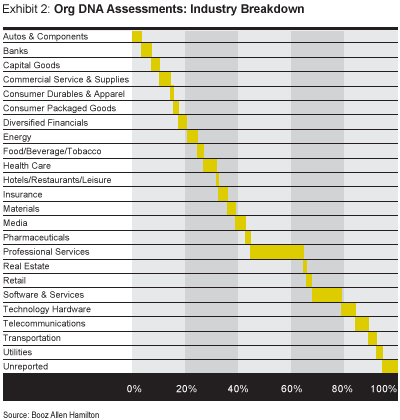
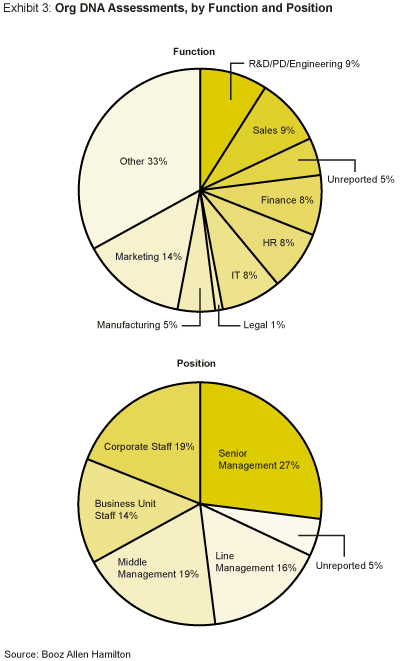
The responses (and the thousands more we have continued to collect) prompt six observations about the prevalence of dysfunction among business organizations and the reasons for their maladies:
1. Most organizations are unhealthy. More than 60 percent of respondents found their organizations fit one of the four species associated with subpar performance: Passive-Aggressive, Fits-and-Starts, Outgrown, or Overmanaged.
2. Organizational DNA changes as companies grow. As a rule, small companies report more Resilient and Just-in-Time behaviors. As they grow, they may centralize and demonstrate more Military traits. Once their annual revenues cross the $1 billion threshold, operations necessarily decentralize, but often badly, as revealed in the higher incidence of Fits-and-Starts and Passive-Aggressive profiles. Once past the $10 billion mark, companies have obviously demonstrated some key success traits but are not necessarily free from dysfunction.
3. Altitude determines attitude. Survey results indicate sharp differences between senior-management responses and those of lower-level personnel, suggesting a disconnect between the organizations that senior executives believe they’ve established and the organizations they are actually running.
4. Nonexecutives feel micromanaged. Although senior managers appear to view their self-professed involvement in operating decisions as good, junior managers overwhelmingly reported feeling a lack of maneuvering room.
5. Decision rights are unclear. More than half of those completing surveys indicated they believed that the accountability for decisions and actions in their organizations was vague.
6. Execution is the exception, not the rule. Fewer than half of all respondents agreed that “important strategic and operational decisions are quickly translated into action” in their organizations. Poor information flows seem mostly to blame.
Unlike humans and other organisms, organizations have the ability to change their DNA by adjusting and adapting their building blocks. Our survey findings suggest steps companies can take both to better understand the nature of their difficulties and to improve their execution capabilities.
The Checkup
Our review of the 4,000-plus assessments showed that most organizations are unhealthy. Of the seven organizational species, only three — Resilient, Just-in-Time, and Military — can be described as relatively free from dysfunction, or “healthy.” Only 27 percent of the survey responses resulted in one of these three healthy profiles. More than 60 percent of respondents indicated that the traits and behaviors of their organizations were unhealthy in some way. Their responses describe firms unable to act decisively or effectively.
The most prevalent species was Passive-Aggressive; 31 percent of respondents reported organizational behaviors consistent with this type. Overmanaged was the second largest category, at 18 percent. The healthiest species is the Resilient firm. Yet only 15 percent of respondents indicated that their companies fit this profile. We found significant differences among industries in their degree of passive-aggressiveness, from a low of 17 percent of people in the durables and apparel sector who indicated their companies fell into this category, to a high of 40 percent among insurance-industry respondents. The surveys show that the more highly regulated the industry, the greater the level of passive-aggressive behavior. Similar variations existed among departments, with overhead and staff functions perceiving passive-aggressiveness in their companies more than manufacturing and sales personnel. (See Exhibit 4.)
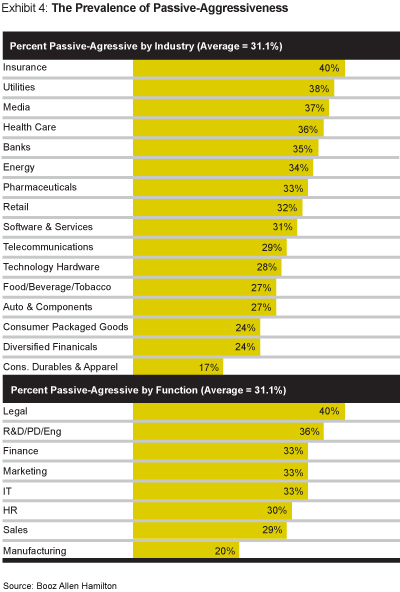
The surveys suggest that companies pass through different “genotypes” as they grow and that they hit a kind of Darwinian barrier when their embedded traits and behaviors hinder their ability to perform according to their aspirations. Astute managers appreciate these subtle shifts and can help their organizations transition to new models as the company expands. (See Exhibit 5.)
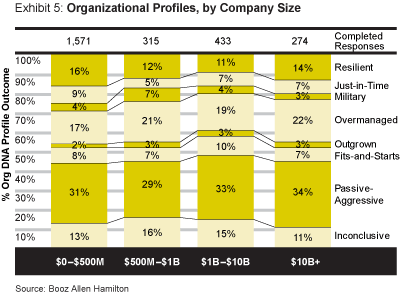
Specifically, in analyzing organizational behaviors by the size of the company, we see a four-step evolutionary process by which companies grow into — and occasionally out of — dysfunction:
Step 1: $0–$500 Million. Responses from small companies are more likely than those from their larger counterparts to indicate Resilient or Just-in-Time profiles — organizations that are effective at executing and adapting to change in their environment. This finding is intuitive because small companies tend to be younger, and therefore more attuned to and aligned with the vision and strategy of the founders. Moreover, their small size allows them to adapt more nimbly to market shifts.
Step 2: $500 Million–$1 Billion. As firms cross the $500 million threshold, many seem to address their growing coordination challenges by centralizing authority in a strong senior team that drives the business. Not surprisingly, the Military profile reaches its peak in this revenue segment. In addition, we see a sharp increase in the Overmanaged profile, suggesting that many firms in this size range become bureaucratic, slow, and overly politicized as an expanding middle management starts to second-guess and interfere in lower-level decision making.
Step 3: $1–$10 Billion. Once past the $1 billion mark, organizations become too large and complex to be run effectively by a small senior team via command-and-control mechanisms. Companies are thus forced to decentralize. Given the marked increase in Fits-and-Starts profiles in this revenue range, the transition to a decentralized organizational model appears to go badly in many cases. Local managers may be given the authority to make decisions, but not the incentives or information to make them well. Passive-Aggressive profiles also increase in companies of this size, because incoherent and uncoordinated structures and processes create inertia, confusion, and ultimately a failure to execute.
Step 4: More than $10 Billion. To survive and grow to this size, companies clearly have had to figure out how to execute and adapt, and Resilient profiles do make a comeback in this segment. Even so, plenty of very large organizations still struggle to execute effectively. Overmanaged profiles increase and Fits-and-Starts profiles decrease in the $10 billion+ segment. This finding suggests that many of the largest companies may try to “fix” a badly decentralized organization by adding layers of management and bureaucracy. Passive-Aggressive is the most prevalent profile in companies of this size, indicating that, although people may agree on the strategic plan, few are really implementing it.
But nothing is preordained. Companies are not fated to cycle through the Military, then Fits-and-Starts, and then Passive-Aggressive phases as they grow. Those firms that are aware of these patterns can anticipate and break them.
Upstairs, Downstairs
Our survey results indicate sharp differences in perception between upper management and lower-level groups, suggesting that senior executives may be out of touch with the rest of their organization. Specifically, senior managers are consistently more optimistic in their views of organizational health, a finding that echoes numerous other organizational research studies.
More than any other group in the organization, senior managers we surveyed saw their firms as “healthy.” Indeed, senior executives were twice as likely as any other group to view their companies as Resilient. Consistent with this comparative optimism, senior management answers translated into unhealthy profiles — Overmanaged, Outgrown, Fits-and-Starts, and Passive-Aggressive — almost 30 percent less often than those of other groups. (See Exhibit 6.)
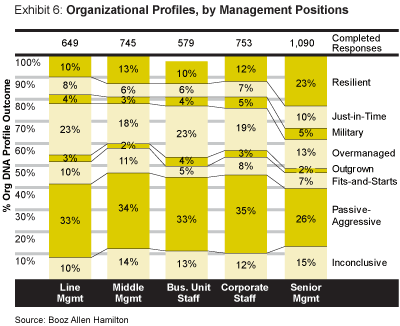
Senior management’s positive bias is reflected in all categories. On virtually every question that tracks to the Resilient profile, senior executives reported the “desirable” response more often than any other segment of respondents. Most strikingly, senior managers were far more willing than others in the organization to agree with the statement, “Important competitive information gets to headquarters quickly.” Given the yawning gap between their perceptions of their organizations’ effectiveness and that of every group that reports to them, one might question how well informed senior managers really are. As business operations grow increasingly complex and the pressure for greater accountability mounts, top management would do well to reassess data flows within the company and institutionalize access to timely, relevant, and accurate information.
These results also appear to indicate a discrepancy between senior executives’ favorable perceptions of the organizational structures and processes they have established, and the actual adoption and utilization of those structures and processes. This finding is consistent with our client experience.
In contrast to their superiors, line managers and midlevel managers and business unit staff tend to be pessimistic in their assessments of organizational effectiveness. Nearly 70 percent of their surveys indicated unhealthy profiles. Line managers and business unit staff feel Overmanaged; 23 percent of them described behavior consistent with this profile. Midlevel and line managers believe their organizations struggle to pull in the same direction at the same time, as evidenced by the high incidence of Fits-and-Starts profiles.
Corporate staff personnel are slightly more optimistic. Perhaps they are far enough removed from daily operations that they are less aware of organizational problems. Most notably, they do not perceive the same Overmanaged behaviors that other nonexecutives report.
One survey question that drew a consistent response across organizational levels was, “Managers above me in the hierarchy ‘get their hands dirty’ by getting involved in operating decisions.” More than half of all respondents reported this happening “frequently,” with senior managers, at 65.4 percent, citing this tendency in their companies more than any other group.
But survey results suggest this is where the consensus ends. Although senior managers likely view their involvement in operating decisions as good (given their overall positive bias), junior managers reported feeling micromanaged. There is widespread agreement among business unit and corporate staff, as well as line managers, that “decisions are often second-guessed.” Fewer senior managers see it that way.
There is also a disparity in beliefs regarding the role of corporate staff. Although business unit staff, line management, and middle management believe that “the primary role of corporate staff is to support the business units,” corporate staff respondents believe their role is to audit those units, a view senior management overwhelmingly supports.
These differences in perception can lead to significant organizational dysfunction. Business unit personnel may feel frustrated as they spend more time reporting up the hierarchy than doing productive work. Not surprisingly, lower-level employees reported a higher incidence of “analysis paralysis” and excessively bureaucratic decision making in their organizations. Feeling distrusted, underestimated, and trapped in an overly politicized environment, those with initiative and exceptional talent may well defect.
Decisions, Decisions
If lower-level employees are feeling stifled by excessive bureaucracy and layers of micromanagement, it could be because decision rights are poorly communicated in many organizations. More than half of the Org DNA Profiler respondents indicated that they felt the accountability for decisions and actions was unclear in their organizations. This finding was consistent across all organizational levels, though senior management was slightly more sanguine.
Although decision rights are vague across the board, the lack of understanding seems particularly acute within overhead functions (e.g., human resources, finance, and information technology), where redundant “shadow staff” frequently multiply to fill the gaps left by incomplete or poorly specified responsibilities. Since so many organizations now outsource overhead functions to third-party vendors, decision rights in those organizations may be hampered by unclear service-level agreements and governance mechanisms. In line organizations (such as manufacturing and sales), decision rights — except at the lowest levels — are slightly clearer, perhaps because those organizations face more direct market pressure to resolve conflicting or poorly specified responsibilities that interfere with responsiveness to the customer.
In combination with generally unclear decision rights, lack of timely and relevant information contributes to ineffective execution. A majority of respondents at all levels reported that “field/line employees frequently lack the information they need to understand the bottom-line impact of their day-to-day choices,” and a majority disagreed with the statement that “information flows freely across organizational boundaries.” As always, senior managers were slightly more upbeat in their assessments, but most still took a dim view in their responses to these questions. (See Exhibit 7.)
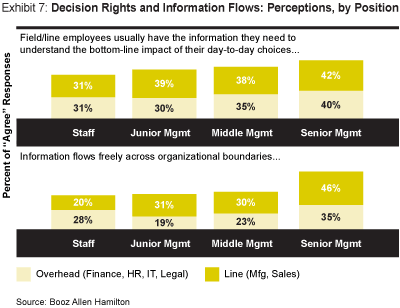
Consistent with their views on decision rights, overhead employees are the most negative in their assessment of information flows. Although still sore points, information access and decision rights are less of a struggle for line organizations. Still, survey responses overwhelmingly point to the need for improved information, tools, and incentives for decision makers in all parts of the organization.
Preliminary results from the Org DNA Profiler assessment tool show that most companies today face organizational impediments to effective and rapid execution. Although 37 percent of respondents from small companies thought their organizations translated strategy into action quickly, only 29 percent of the respondents from the largest companies agreed with that statement.
Respondents at all levels in companies across industries indicated that their organizations struggle to execute decisively and effectively. Fewer than one-third of nonexecutive respondents agreed that “important strategic and operational decisions are quickly translated into action” in their organizations. Even at the most senior levels, fewer than 50 percent of respondents indicated that their companies act decisively in implementing strategy. Whether they fall into the Passive-Aggressive profile or the Outgrown, their organizational DNA is thwarting their own best efforts — and ultimate success.
As they confront their problems, companies are also contending with an increasingly complex global marketplace, where change buffets them relentlessly. According to our early results, fewer than half of the Org DNA Profiler respondents at all nonexecutive levels agreed that their companies “deal successfully with discontinuous change in the competitive environment.” Even among senior managers, only half agreed with this statement.
Gene Therapy
When an organization’s DNA is poorly configured, the firm exhibits unhealthy symptoms and counterproductive behaviors. The first step in fixing these problems is to identify and isolate them. That is the purpose of the Org DNA Profiler assessment tool. Using a framework that examines all aspects of a company’s architecture, resources, and relationships, the tool allows management to gain insight into what is and is not working deep inside a highly complex organization.
But generating a profile is not the point; it is only an exercise designed to focus leaders on the root causes of their organizations’ dysfunctions and execution problems. It is up to management to translate these findings into sustainable solutions. Using the Org DNA Profiler as a starting point for discussion, top executives, business unit heads, and staff leaders (a group that might be 10 people or more than 100) can meet to identify the impediments to effective execution in their organization and develop programs and processes to overcome them. The organizational DNA framework helps companies identify and expose hidden strengths and entrenched weaknesses so that managers can focus efforts on reinforcing what works in their organization and modifying what does not.![]()
|
The Org DNA Profiler™ Methodology |
|
The Org DNA Profiler™ assessment tool categorizes organizational character based on employees’ responses to a five-minute survey composed of 19 questions. This assessment tool, although based on individuals’ survey responses, focuses on the traits and behaviors of the organization as a whole rather than on the individuals who populate it, although certain general demographic data (e.g., position/level, division, industry, annual revenue) is collected to enhance the analysis. Each question addresses organizational behavior with regard to one of the four building blocks of organizational DNA: decision rights, information, motivators, and structure. The responses are then fed through proprietary software that assigns the organization described to one of seven organizational species. |
Reprint No. 04210
Gary Neilson (neilson_gary@bah.com) is a senior vice president with Booz Allen Hamilton in Chicago. He works on the development of organizational models and designs, restructuring, and the leadership of major change initiatives for Fortune 500 companies.
Bruce A. Pasternack (pasternack_bruce@bah.com) is a senior vice president with Booz Allen Hamilton in San Francisco. He counsels companies in building strategic agendas, developing organizations, and transforming business models. He has published widely on leadership and organizational issues.
Decio Mendes (mendes_decio@bah.com) is a senior associate with Booz Allen Hamilton in New York. He works with clients to improve organizational effectiveness and operations efficiency.


